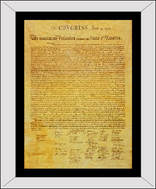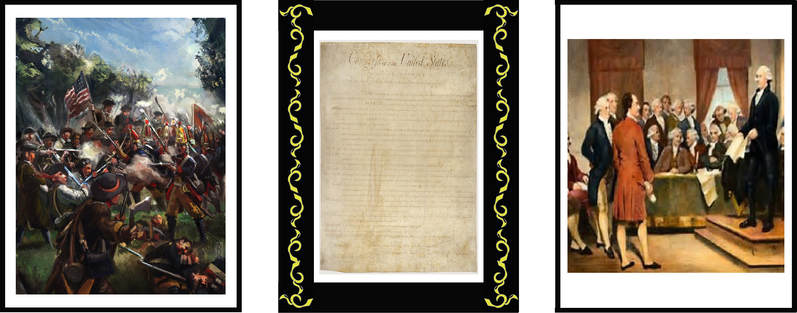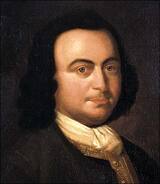Written by, Eddie Joe Bush
Formation of the United States began with British colonial settlers building thirteen separate governments in America and delegates from each one uniting in September 1774 to create a law-making advisory council they denominated, "Continental Congress." The governing powers of the congress were set forth in a document entitled, "Articles of Confederation."
|
Ending Britain's rule over the American colonies occurred during the 1775 American Revolutionary War that exploded consequential to the colonies' militiamen (led by George Washington), resisting King George, III forcing the settlers to comply with his tyrannical tax laws meant to cure England's lingering debt that was passed on to him from generation to generation beginning the Queen Elizabeth I and King James I eras. Consequently, George engaged in a war against France between 1756 and 1763 (known as the French and Indian War) (depicted right). And in doing so, put England deeper in war debt. Although the colonies militiamen were willing to help England win that war, they were unwilling, afterwards, to pay George tyrannical taxes to solve Britain's debt problem. Which, according to most accounts of George's reign as King of England (and Scotland as well), was compounded by his lavish lifestyle.
|
|
Thomas Jefferson drafted the Declaration of Independence on July 2, 1776. He went straight to the heart of the matter declaring the colonies were, "United States of America." It was reviewed and approved by the Continental Congress on July 4. During its review Congress contemplated the correct interpretation of 'independence.' And application of its meaning to the colonies' sovereignty (i.e., worldly recognition as an independent nation). Some argued "independence" represented the definition of thirteen states independent of Britain, as well as, each other. On the other hand, some felt it represented one sovereignty that engulfs all the 13 states combined. Accordingly, it can be assumed: Keeping in mind that the colonies were fighting united against Britain, it became accepted by all concerned, Jefferson's wording of the Declaration of Independence clarified what it represented is: the thirteen colonies were (collectively) an independent nation of thirteen separate States that were united. Subsequently, the document was approved by Congress on July 4, 1776. [Shown right]
|
On September 2, 1783 the American Revolutionary War officially ended between Britain and the United States in France with signing of the Paris Peace Treaty. It took place there because: Ironically, (after the 1756 French and Indian War was lost by France to Britain with help of the colonial militiamen), it was the aid France gave to the colonial militiamen that helped them win the 1775 Revolutionary War.
Creation of the United States Constitution began in 1786. Violations of contractual and property rights, the depreciation of the value of money due to more of it in circulation than was backed by precious metals (among many other state government problems) heightened clamor and nearing the winter of that year gave birth in Massachusetts to Daniel Shays' Rebellion. In response to the threat of that occurring elsewhere the conclusion was reached there was need for the states to be regulated by a document representing the supreme law of the land governing all the states. Essentially, there were two conventions dealing with that. The first was held in Annapolis, Minnesota during September, 1786, which failed to accomplish anything significant due to its poor attendance. The second meeting was held in Philadelphia during May, 1787, and got underway within the same building the Declaration of Independence had been ratified.
Creation of the United States Constitution began in 1786. Violations of contractual and property rights, the depreciation of the value of money due to more of it in circulation than was backed by precious metals (among many other state government problems) heightened clamor and nearing the winter of that year gave birth in Massachusetts to Daniel Shays' Rebellion. In response to the threat of that occurring elsewhere the conclusion was reached there was need for the states to be regulated by a document representing the supreme law of the land governing all the states. Essentially, there were two conventions dealing with that. The first was held in Annapolis, Minnesota during September, 1786, which failed to accomplish anything significant due to its poor attendance. The second meeting was held in Philadelphia during May, 1787, and got underway within the same building the Declaration of Independence had been ratified.
|
The American Revolutionary War giving birth to a federal government (document), that, when enforced, manages civil obedience in all thirteen states required well organized: (a) discussions; (b) proposals; (c) debates; and (d) voting for and against. The final document is divided into four categories of power: 1. Executive; 2. Legislative; 3. Judicial and; 4. The People. The person instrumental to achieving the fourth power was George Mason (pictured left). He was the first to protest against ratification of the constitution because it failed to include a citizen's bill of rights. Thus, Amendments 1 - 10 to the original constitution were made. |
In general, there are two voting ballads: One for the common citizenry, called, 'Popular,' and the other for those who've been elected as State Representatives and Federal Senators, called, 'Electoral.' The majority winner of these voting ballads determines who the President of the United States will be. In all other cases, public officials are elected by a majority of the 'Popular' vote. Or else, they're appointed to head a public department or agency by an executive official, (i.e., the President, or else, State Governor).
Democratic elections require there be at least two political parties competing against each other to win an elections race. Which, commonly, in the United States are named, "Democrat" and "Republican" parties. Other parties are referred to as, "Independents."
In the nation's capital, (Washington D.C.), State Representatives form the "House," and Federal Senators form the "Senate." Together, they form the United States of America "Congress." Whose primary job is to provide for the nation's defense and enact constitutional law. The lawmaking procedure is called, "Legislature."
State judges are elected by a majority of popular votes. And Federal judges are nominated by the President and then approved or disapproved by Congress. If approved, the President is authorized to appoint them to fill a vacancy existing in a district court, circuit court of appeals, or, supreme court of the United States.
State and Federal courts are vested with "Judiciary" authority and power to settle disputes and controversies, (including civil and criminal cases), and authority to enforce judgments. Generally, State courts have "Police Officer" authority and use of force statewide within cities, counties, and municipalities. And Federal courts, generally, have "Police Agent" authority and use of force nationwide within districts and territories of the United States. Courts also have jurisdiction over jails, correctional facilities, and prisons.
"Military" authority and use of force rests with State Legislators, Governors; President of the United States, and Congress.
In a nutshell, under the Constitution: State Governors and the United States President possess "Executive" administrative powers; State Representatives and Federal Senators possess "Legislation" administrative powers; and State and Federal Judges possess "Judicial" administrative powers. While, on the other hand, under the Declaration of Independence: We The People possess "Militia" powers.
Democratic elections require there be at least two political parties competing against each other to win an elections race. Which, commonly, in the United States are named, "Democrat" and "Republican" parties. Other parties are referred to as, "Independents."
In the nation's capital, (Washington D.C.), State Representatives form the "House," and Federal Senators form the "Senate." Together, they form the United States of America "Congress." Whose primary job is to provide for the nation's defense and enact constitutional law. The lawmaking procedure is called, "Legislature."
State judges are elected by a majority of popular votes. And Federal judges are nominated by the President and then approved or disapproved by Congress. If approved, the President is authorized to appoint them to fill a vacancy existing in a district court, circuit court of appeals, or, supreme court of the United States.
State and Federal courts are vested with "Judiciary" authority and power to settle disputes and controversies, (including civil and criminal cases), and authority to enforce judgments. Generally, State courts have "Police Officer" authority and use of force statewide within cities, counties, and municipalities. And Federal courts, generally, have "Police Agent" authority and use of force nationwide within districts and territories of the United States. Courts also have jurisdiction over jails, correctional facilities, and prisons.
"Military" authority and use of force rests with State Legislators, Governors; President of the United States, and Congress.
In a nutshell, under the Constitution: State Governors and the United States President possess "Executive" administrative powers; State Representatives and Federal Senators possess "Legislation" administrative powers; and State and Federal Judges possess "Judicial" administrative powers. While, on the other hand, under the Declaration of Independence: We The People possess "Militia" powers.
© 2024, All Rights Reserved













